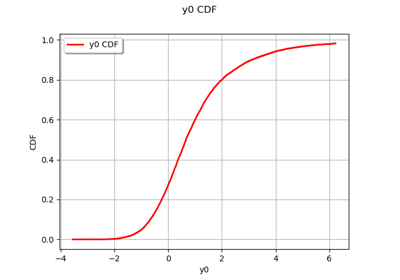Wilks¶
- class Wilks(*args)¶
Class to evaluate the Wilks number.
Refer to Estimation of a quantile by Wilks’ method.
- Parameters:
- randomVector
RandomVectorof dimension 1 Output variable of interest.
- randomVector
Notes
This class is a static class which enables the evaluation of the Wilks number: the minimal sample size
to perform in order to guarantee that the empirical quantile
, noted
evaluated with the
maximum of the sample, noted
be greater than the theoretical quantile
with a probability at least
:
where
.
Methods
ComputeSampleSize(quantileLevel, confidenceLevel)Evaluate the size of the sample.
computeQuantileBound(quantileLevel, ...[, ...])Evaluate the bound of the quantile.
- __init__(*args)¶
- static ComputeSampleSize(quantileLevel, confidenceLevel, marginIndex=0)¶
Evaluate the size of the sample.
- Parameters:
- alphapositive float
The order of the quantile we want to evaluate.
- betapositive float
Confidence on the evaluation of the empirical quantile.
- iint
Rank of the maximum which will evaluate the empirical quantile. Default
(maximum of the sample)
- alphapositive float
- Returns:
- wint
the Wilks number.
- computeQuantileBound(quantileLevel, confidenceLevel, marginIndex=0)¶
Evaluate the bound of the quantile.
- Parameters:
- alphapositive float
The order of the quantile we want to evaluate.
- betapositive float
Confidence on the evaluation of the empirical quantile.
- iint
Rank of the maximum which will evaluate the empirical quantile. Default
(maximum of the sample)
- alphapositive float
- Returns:
- q
Point The estimate of the quantile upper bound for the given quantile level, at the given confidence level and using the given upper statistics.
- q
 OpenTURNS
OpenTURNS
